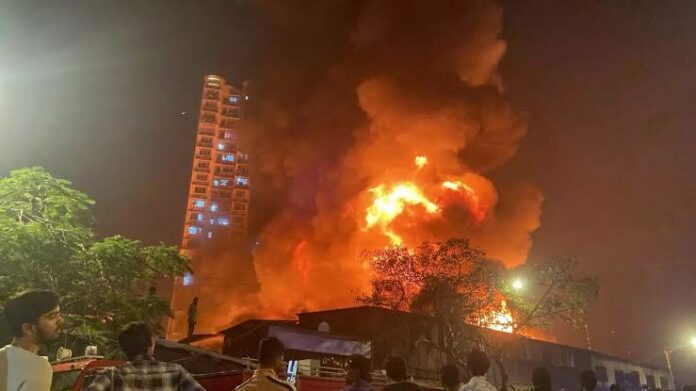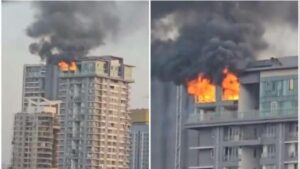A terrifying Mumbai fire erupted at a corporate park in Mulund, sending shockwaves through the bustling neighborhood. The blaze, which started around 9:25 am, trapped nearly 50 people inside the six-storey building. Panic ensued as thick smoke engulfed the premises, making it difficult for occupants to find a safe escape route. The harrowing ordeal unfolded amidst frantic calls for help and desperate attempts to contain the spreading flames.
As the flames spread rapidly, rescue teams sprang into action, navigating through the chaos to reach those trapped inside. Firefighters, equipped with breathing apparatuses and protective gear, heroically entered the smoke-filled building to rescue stranded individuals. Despite the intense heat and challenging conditions, they remained steadfast in their mission to save lives. With each successful evacuation, hope flickered amid the darkness of uncertainty.
Table of Contents
Emergency Response and Evacuation
The Brihanmumbai Municipal Corporation (BMC) spearheaded the rescue operation, deploying four fire engines, three jumbo tankers, and two turn-table ladders. Mumbai police and other agencies joined forces to contain the Mumbai fire. Miraculously, no injuries were reported, and the fire remained confined to the building’s sixth floor. The coordinated efforts of emergency responders, coupled with effective evacuation protocols, prevented a potential disaster of catastrophic proportions.
Despite the swift response, questions lingered about the adequacy of fire safety measures in commercial buildings. Concerns were raised about the maintenance of electrical wiring and installations, as well as the accessibility of emergency exits. The incident underscored the importance of regular safety audits and rigorous enforcement of building codes to prevent similar tragedies in the future.
US Bridge Collapses: Shocking Footage Unveils Terrifying Reality!
Extent of Damage and Recovery Efforts
The Mumbai fire wreaked havoc on the corporate park, damaging electrical wiring, installations, AC units, furniture, and office records. The inferno engulfed an area spanning approximately 1,000 square feet, leaving a trail of destruction in its wake. As firefighters battled the blaze, questions arose about the adequacy of fire safety measures in commercial buildings across the city. The incident served as a wake-up call for policymakers, urging them to prioritize fire safety measures in urban planning and development.
Previous Incidents and Safety Concerns
The Mulund fire adds to a string of recent fire incidents in Mumbai, including one in Antop Hill and another near a bridge repair site in Thane. While prompt action from authorities prevented casualties, these incidents underscore the urgent need for stricter enforcement of fire safety protocols. The safety of residents and workers must take precedence in urban development plans.
LATAM Airlines Flight Horror: Unraveling the Sydney-Auckland Incident
Lessons Learned and Preventive Measures
In the aftermath of the Mumbai fire, authorities pledged to conduct thorough investigations into the cause of the blaze. Stricter adherence to building codes and regular safety inspections emerged as crucial strategies to prevent similar tragedies. Public awareness campaigns on fire safety and emergency preparedness gained momentum, empowering citizens to take proactive measures.
Community Resilience and Support
Despite the devastation caused by the Mumbai fire, stories of heroism and community resilience emerged. The swift evacuation of trapped individuals and the coordinated efforts of emergency responders exemplified the city’s resilience in the face of adversity. Support poured in from all quarters, highlighting the importance of solidarity during times of crisis.
Rebuilding and Moving Forward
As the embers of the Mumbai fire smoldered, the city embarked on a journey of recovery and reconstruction. Efforts to rebuild damaged structures and support affected families gained momentum. The incident served as a wake-up call for policymakers, urging them to prioritize fire safety measures in urban planning and development.
Conclusion
The Mumbai fire at the corporate park in Mulund serves as a stark reminder of the urgent need for robust fire safety measures in commercial buildings. Prompt response and effective evacuation procedures saved lives, but the incident underscores the importance of proactive prevention strategies. As the city rallies together to rebuild and recover, lessons learned from this tragedy must guide future efforts to safeguard lives and property from the ravages of fire.
FAQ’s (Frequently Asked Questions)
1. What caused the Mumbai fire in the corporate park?
– The exact cause of the fire is still under investigation by authorities, but preliminary reports suggest it may have been due to faulty electrical wiring.
2. How many people were trapped inside the building during the fire?
– Nearly 50 people were trapped inside the six-storey corporate park when the fire broke out, according to the Brihanmumbai Municipal Corporation (BMC).
3. Were there any casualties reported from the Mumbai fire?
– Fortunately, no injuries or casualties were reported as a result of the fire. Rescue teams managed to evacuate all stranded individuals safely.
4. What measures are being taken to prevent similar incidents in the future?
– Authorities have pledged to conduct thorough investigations and enforce stricter adherence to building codes and fire safety regulations. Public awareness campaigns on fire safety are also being intensified.
5. How did emergency responders manage to contain the fire?
– The Brihanmumbai Municipal Corporation (BMC) deployed multiple fire engines, jumbo tankers, and turn-table ladders to combat the blaze. Coordination among Mumbai police and other agencies played a crucial role in containing the fire.
6. What lessons can be learned from the Mumbai fire incident?
– The incident highlights the importance of proactive fire safety measures, regular safety audits, and effective emergency response protocols in commercial buildings. It serves as a reminder for policymakers to prioritize the safety of residents and workers in urban development plans.














